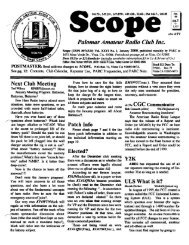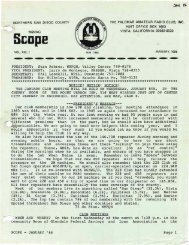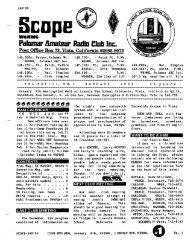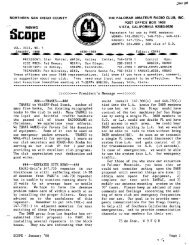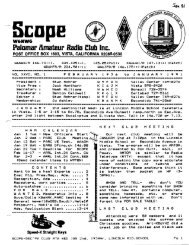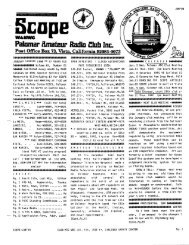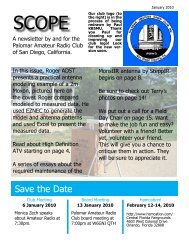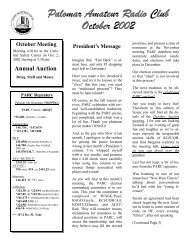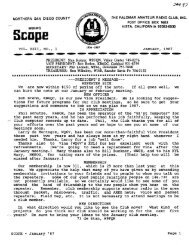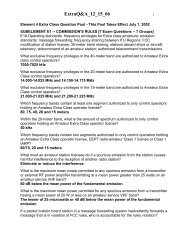Create successful ePaper yourself
Turn your PDF publications into a flip-book with our unique Google optimized e-Paper software.
On August 4, 1985, Bob Gonsett (WA6QgQ) and Dee Crumpton (N6ELP) set up<br />
a homebrew antenna range and used professional test gear to determine<br />
the relative gains of various handy-talkie antennas. Simply put, they<br />
pooled their collection of 1ft' antennas, chose one at random as a ·standard"<br />
(a stock IcOlD. IC-2A rubber duck) and tested each of the remaining antennas<br />
on two radios and in two environmental settings (antenna ranges "A" & "B").<br />
The results of their tests are attached.<br />
aT antenna gain measurements are difficult to make because of the variations<br />
in the ways the radios (and therefore the antennas) are held and<br />
the way individual radios tend to load into a given antenna. Indeed,<br />
the operator is part of the antenna system and imparts directional<br />
characteristics to the radiated pattern. Keeping this in mind, an<br />
attempt was made to "average out" any directional properties by having<br />
the aT operator (N6ELP) transmit continuously while walking around the<br />
perimeter of a lo-foot diameter circle. The receiving antenna (a 20'<br />
AGL quarter wave ground plane about 100 feet away) was thus exposed to<br />
,all sides of the transmitted signal. Two aTs were used to test the idea<br />
of PA loading variations.<br />
The ground plane receiving antenna was connected to half inch diameter<br />
hardline coax and terminated in a Potomac Instruments Type FIM-7l field<br />
strength meter which in turn was connected to an Esterline Angus Model<br />
MS40lBB servo driven strip chart recorder. WA6QQQ supervised the<br />
measuring program and analyzed the data in order to determine the<br />
median strength of each antenna tested. The gain of the reference IC-2A<br />
antenna was measured at the beginning, middle and end of each series of<br />
measurements and the median of these values was defined as a dB gain<br />
(against which the other antennas were compared). This procedure also<br />
permitted the aT's output powers to be checked for stability (no significant<br />
variations were found).<br />
Finally, two supplemental tests were run. First, when the reference<br />
ICOM IC-2A antenna was used, the apparent antenna gain dropped by 11 to<br />
27 dB when the aTs were belt mounted. (Don I t belt mount your aT and<br />
expect to be able to transmit any distance!) However, when the antenna<br />
was clipped to a metal headband and connected to a belt mounted aT with<br />
a short length of coax (this assembly made by a company in Dayton,<br />
Ohio), near normal antenna gain was restored... In both cases, however,<br />
increased multipath was noted on the strip chart recorder.<br />
Enjoy the results of the measurements. While they're not elaborate,<br />
they will help you separate fact from fiction in a field where rumors<br />
abound.<br />
Scope - December '89 Page 10



